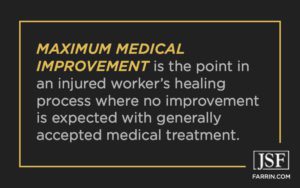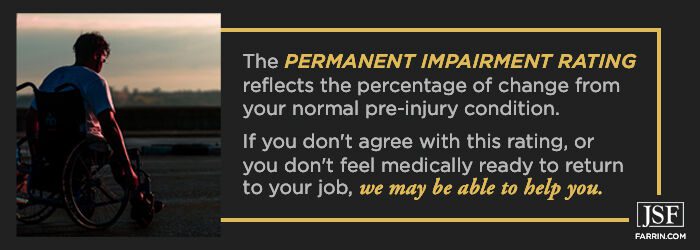It’s bad enough that you’ve been hurt on the job.You want to get better and return to work, but you don’t want to go back to work too soon and risk further injury or hurt your chances for a full recovery. Most people who’ve been through a workers’ compensation claim can tell you, things can get complicated pretty quickly. And your recovery may often seem like it gets lost among the noise of this complicated machine known as the workers’ compensation system.
Oftentimes, insurance companies will send injured workers to doctors they prefer. We’ve seen over and over that sometimes these doctors may clear our clients to go back to their jobs before they feel ready.
If you don’t feel you are medically ready to return to your job, contact us immediately. We may be able to help you get another doctor’s opinion.
What Is Maximum Medical Improvement (MMI)?

However, if you still have deformity, pain, weakness, or loss of function that has not improved through medical treatment, your doctor may assign you a “permanent impairment rating.” A permanent impairment rating is supposed to reflect the percentage of change from your normal pre-injury condition. If you receive this rating, it is applied to a workers’ compensation injury chart (which is broken down by body part) to determine your benefits.
If you don’t agree with this rating, or you don’t feel medically ready to return to your job, we can help you take the necessary steps to try to get a second opinion with a doctor you choose. Not necessarily one the insurance company chooses!
NC Permanent Impairment Chart: Total Loss Compensation
Most of our clients are shocked to learn that North Carolina state law sets a maximum amount of compensation for each body part. Here is a list of the maximum number of weeks you could receive benefits for a total loss of body parts:
| NC Compensation for a Permanent Impairment | |||
| Body Part | Weeks of Compensation for a Complete Loss | ||
| Thumb | 75 weeks | ||
| First Finger | 45 weeks | ||
| Second Finger | 40 weeks | ||
| Third Finger | 25 weeks | ||
| Fourth Finger | 20 weeks | ||
| Big Toe | 35 weeks | ||
| Other Toe | 10 weeks | ||
| Hand | 200 weeks | ||
| Arm | 240 weeks | ||
| Foot | 144 weeks | ||
| Leg | 200 weeks | ||
| Eye | 120 weeks | ||
| Back | 300 weeks | ||
NC Permanent Impairment Chart: Partial Loss Compensation
For anything less than total loss, benefits are figured on a percentage basis. For example, a 10% partial impairment rating to the leg would be worth 20 weeks of benefits at your average weekly wage rate. A 10% rating to your back would be worth 30 weeks at your weekly compensation rate.
Based on a 10% Permanent Partial Impairment Rating
| NC Compensation for a Permanent Partial Impairment | |||
| Body Part | Weeks of Compensation for 10% Rating | ||
| Thumb | 7.5 weeks | ||
| First Finger | 4.5 weeks | ||
| Second Finger | 4 weeks | ||
| Third Finger | 2.5 weeks | ||
| Fourth Finger | 2 weeks | ||
| Big Toe | 3.5 weeks | ||
| Other Toe | 1 weeks | ||
| Hand | 20 weeks | ||
| Arm | 24 weeks | ||
| Foot | 14.4 weeks | ||
| Leg | 20 weeks | ||
| Eye | 12 weeks | ||
| Back | 30 weeks | ||
The North Carolina Industrial Commission publishes a ratings guide to help physicians make impairment evaluations. Here are those rating guidelines that include impairments such as the following:
- Shortening of the leg
- Rotation of the hip
- Motion of the knee, foot, and ankle
- Optimum position of the fingers, elbow, and shoulder
- Fractures
- Lacerations
- Nerve injuries
- Back injuries
- And more
If your workers’ comp claim has been approved, you are likely entitled to receive this payment for permanent impairment even if you are able to go back to work and even if you don’t have any reduction to your wages. This partial workers’ compensation settlement is made in a lump sum, usually when the injured worker goes back to work for the same employer earning the same wages as before the injury. Under this kind of partial settlement, the injured worker retains the right to request additional medical treatment for another two years.
If you disagree with the doctor’s rating, you are entitled to get a second opinion from another doctor of your choosing. The Industrial Commission will average the two ratings to determine what workers’ compensation benefits you may be entitled to.
If, however, your healing period ends and you are still unable to return to work, you can choose to continue receiving weekly compensation checks instead of payment for your disability rating. Except under special circumstances, you can only receive weekly benefits for a total of 500 weeks from the date you became disabled.
Complicated, isn’t it?
Bottom Line for Injured Workers: Talk to an Experienced Workers’ Compensation Attorney
Workers’ compensation laws can be extremely confusing and complicated. That’s why we believe it’s best to have legal guidance to help you try to make the right decisions at every step of this process. Our workers’ compensation lawyers have the training and the experience to help you potentially get the medical treatment and compensation you need.
Get Your Workers’ Compensation Case Evaluated for Free
Many of us are North Carolina State Bar Board Certified Workers’ Compensation Specialists.
Out of the less than 31,500 attorneys licensed to practice in North Carolina, fewer than 175 can claim that distinction.* We also have a former Special Deputy Commissioner, and a former Deputy Commissioner from the North Carolina Industrial Commission (one of whom was a state senator).
When you’re injured, the last thing you need is to try to become a workers’ compensation attorney and decipher a workers’ comp settlement chart in order to figure out what workers’ comp benefits you may be entitled to. We can do that for you. You just need to focus on getting better and trying to get a check to put food on the table for your family during your recovery.
*NC Board Certification figures provided by the NC State Bar through January 2022.
You May Also Be Interested In
What Happens if You Can’t Recover From an On-the-Job Injury?
What Is a Functional Capacity Evaluation?
I’ve Been Given a Workers’ Comp Rating. Should I Close My Case?
Do I Need a Workers’ Compensation Attorney?






